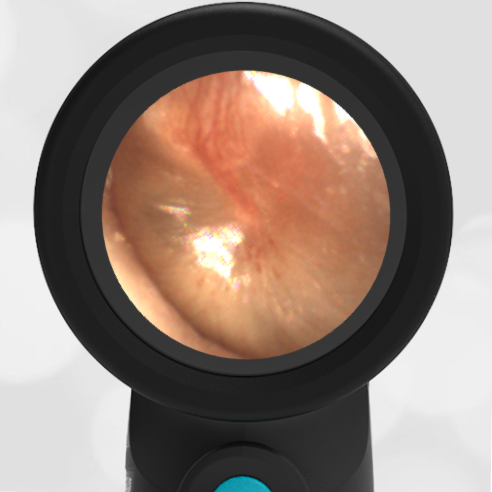
3-Year-Old with Ear Pain
A 3-year-old female presented to the emergency department (ED) for evaluation of ear pain that started earlier in the day. The child’s mother reported her daughter had a week of nasal congestion but no fever until last night when she was subjectively warm. She had an ear infection last winter but otherwise had only the usual “daycare illnesses.” Her Wispr digital otoscope exam is attached below.
Which of the following is true?
A. This is her left tympanic membrane (TM, eardrum), and it is mildly bulging
B. This is her right TM, and it is mildly bulging
C. This is her left TM, and it is severely bulging
D. This is her right TM, and it is severely bulging

An important skill in assessing the TM is the ability to identify the malleus since this is the bony landmark that becomes obscured as bulging occurs. In addition, the malleus very nicely orients the clinician to the TM laterality. If one imagines the TM as the face of a clock, the malleus can be thought of as the arm, with the umbo attachment at the center and the manubrium and lateral process extending outward toward the numbers. In this analogy, the arm of the clock will point toward the side of the TM being visualized. When bulging occurs, the malleus can be difficult to find but, in most instances, the tip of the lateral process can still be identified—sometimes as a small white “dot” located near the periphery of the TM. Further clues to its location are the injected blood vessels coursing over the malleus, which become prominent with TM inflammation.
Determining the degree of bulging is subjective. However, the appearance of an angry donut sign where the fixed attachment of the umbo creates a deep central donut hole, is easily recognizable as “severe bulging”. With lesser bulging, the umbo attachment creates a shallower depression, and the TM is often described as “full”.
Key Learning Points
- Bulging of the tympanic membrane occurs on a spectrum from mild to moderate to severe.
- Treatment for acute otitis media depends on the degree of bulging and symptoms such as pain and fever.
Stay Updated on Clinical Cases. Get the latest cases delivered to your inbox.


